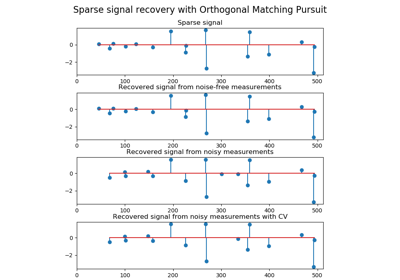sklearn.linear_model.OrthogonalMatchingPursuit¶
-
class
sklearn.linear_model.OrthogonalMatchingPursuit(n_nonzero_coefs=None, tol=None, fit_intercept=True, normalize=True, precompute='auto')[source]¶ Orthogonal Matching Pursuit model (OMP)
Read more in the User Guide.
- Parameters
- n_nonzero_coefsint, optional
Desired number of non-zero entries in the solution. If None (by default) this value is set to 10% of n_features.
- tolfloat, optional
Maximum norm of the residual. If not None, overrides n_nonzero_coefs.
- fit_interceptboolean, optional
whether to calculate the intercept for this model. If set to false, no intercept will be used in calculations (i.e. data is expected to be centered).
- normalizeboolean, optional, default True
This parameter is ignored when
fit_interceptis set to False. If True, the regressors X will be normalized before regression by subtracting the mean and dividing by the l2-norm. If you wish to standardize, please usesklearn.preprocessing.StandardScalerbefore callingfiton an estimator withnormalize=False.- precompute{True, False, ‘auto’}, default ‘auto’
Whether to use a precomputed Gram and Xy matrix to speed up calculations. Improves performance when n_targets or n_samples is very large. Note that if you already have such matrices, you can pass them directly to the fit method.
- Attributes
- coef_array, shape (n_features,) or (n_targets, n_features)
parameter vector (w in the formula)
- intercept_float or array, shape (n_targets,)
independent term in decision function.
- n_iter_int or array-like
Number of active features across every target.
See also
orthogonal_mporthogonal_mp_gramlars_pathLarsLassoLarsdecomposition.sparse_encodeOrthogonalMatchingPursuitCV
Notes
Orthogonal matching pursuit was introduced in G. Mallat, Z. Zhang, Matching pursuits with time-frequency dictionaries, IEEE Transactions on Signal Processing, Vol. 41, No. 12. (December 1993), pp. 3397-3415. (http://blanche.polytechnique.fr/~mallat/papiers/MallatPursuit93.pdf)
This implementation is based on Rubinstein, R., Zibulevsky, M. and Elad, M., Efficient Implementation of the K-SVD Algorithm using Batch Orthogonal Matching Pursuit Technical Report - CS Technion, April 2008. https://www.cs.technion.ac.il/~ronrubin/Publications/KSVD-OMP-v2.pdf
Examples
>>> from sklearn.linear_model import OrthogonalMatchingPursuit >>> from sklearn.datasets import make_regression >>> X, y = make_regression(noise=4, random_state=0) >>> reg = OrthogonalMatchingPursuit().fit(X, y) >>> reg.score(X, y) 0.9991... >>> reg.predict(X[:1,]) array([-78.3854...])
Methods
fit(self, X, y)Fit the model using X, y as training data.
get_params(self[, deep])Get parameters for this estimator.
predict(self, X)Predict using the linear model.
score(self, X, y[, sample_weight])Return the coefficient of determination R^2 of the prediction.
set_params(self, \*\*params)Set the parameters of this estimator.
-
__init__(self, n_nonzero_coefs=None, tol=None, fit_intercept=True, normalize=True, precompute='auto')[source]¶ Initialize self. See help(type(self)) for accurate signature.
-
fit(self, X, y)[source]¶ Fit the model using X, y as training data.
- Parameters
- Xarray-like, shape (n_samples, n_features)
Training data.
- yarray-like, shape (n_samples,) or (n_samples, n_targets)
Target values. Will be cast to X’s dtype if necessary
- Returns
- selfobject
returns an instance of self.
-
get_params(self, deep=True)[source]¶ Get parameters for this estimator.
- Parameters
- deepbool, default=True
If True, will return the parameters for this estimator and contained subobjects that are estimators.
- Returns
- paramsmapping of string to any
Parameter names mapped to their values.
-
predict(self, X)[source]¶ Predict using the linear model.
- Parameters
- Xarray_like or sparse matrix, shape (n_samples, n_features)
Samples.
- Returns
- Carray, shape (n_samples,)
Returns predicted values.
-
score(self, X, y, sample_weight=None)[source]¶ Return the coefficient of determination R^2 of the prediction.
The coefficient R^2 is defined as (1 - u/v), where u is the residual sum of squares ((y_true - y_pred) ** 2).sum() and v is the total sum of squares ((y_true - y_true.mean()) ** 2).sum(). The best possible score is 1.0 and it can be negative (because the model can be arbitrarily worse). A constant model that always predicts the expected value of y, disregarding the input features, would get a R^2 score of 0.0.
- Parameters
- Xarray-like of shape (n_samples, n_features)
Test samples. For some estimators this may be a precomputed kernel matrix or a list of generic objects instead, shape = (n_samples, n_samples_fitted), where n_samples_fitted is the number of samples used in the fitting for the estimator.
- yarray-like of shape (n_samples,) or (n_samples, n_outputs)
True values for X.
- sample_weightarray-like of shape (n_samples,), default=None
Sample weights.
- Returns
- scorefloat
R^2 of self.predict(X) wrt. y.
Notes
The R2 score used when calling
scoreon a regressor will usemultioutput='uniform_average'from version 0.23 to keep consistent withr2_score. This will influence thescoremethod of all the multioutput regressors (except forMultiOutputRegressor). To specify the default value manually and avoid the warning, please either callr2_scoredirectly or make a custom scorer withmake_scorer(the built-in scorer'r2'usesmultioutput='uniform_average').
-
set_params(self, **params)[source]¶ Set the parameters of this estimator.
The method works on simple estimators as well as on nested objects (such as pipelines). The latter have parameters of the form
<component>__<parameter>so that it’s possible to update each component of a nested object.- Parameters
- **paramsdict
Estimator parameters.
- Returns
- selfobject
Estimator instance.

